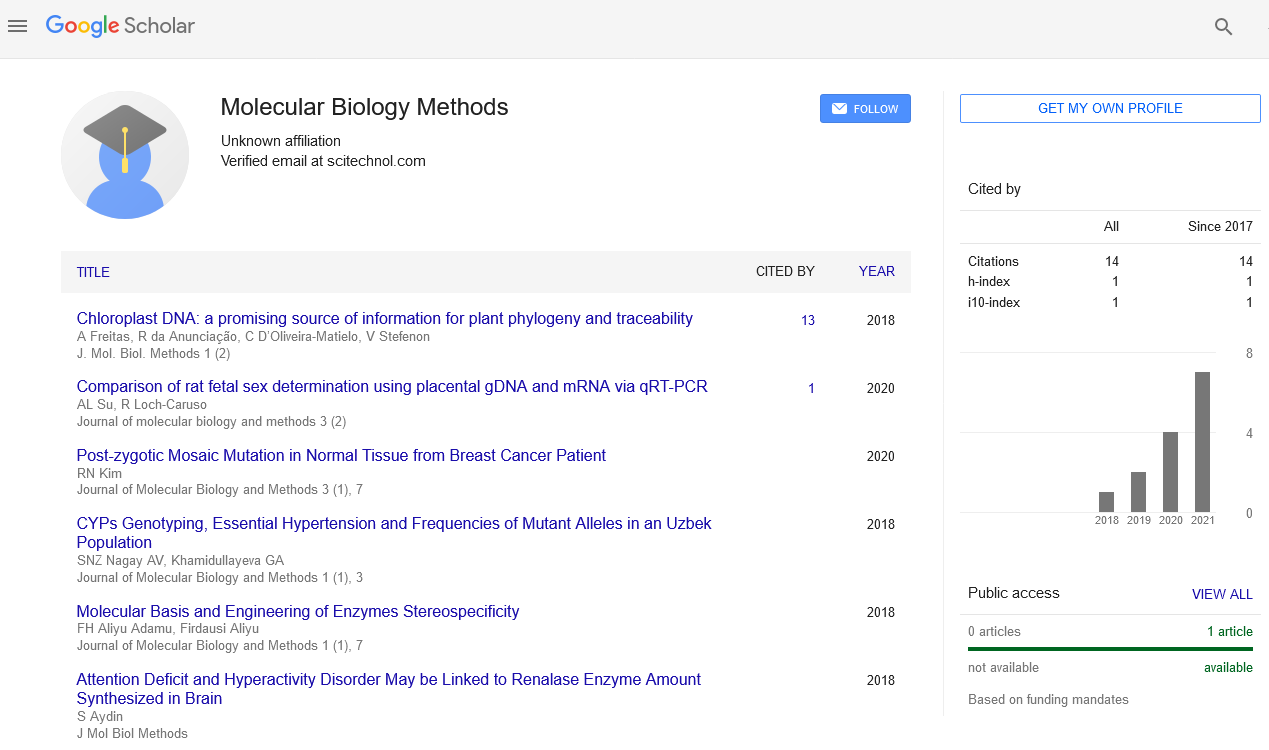Commentary, J Mol Biol Methods Vol: 4 Issue: 6
Different Cell Organelles and their Functions
Nibin Chang*
Department of Molecular Engineering, University of Central Florida, Orlando, USA
- Corresponding Author:
- Nibin Chang
Department of Molecular Engineering, University of Central Florida, Orlando, USA
E-mail: nchang@ucf.edu
Received date: November 03, 2021; Accepted date: November 18, 2021; Published date: November 25, 2021
Keywords: Cell Organelles
Description
Every cell in your body contains organelles structures that have specific functions. A bit like organs within the body, every cell organ contributes in its own thanks to serving to the cell perform well as an entire. The nucleus, mitochondria and chloroplasts area unit all organelles. Despite their central importance to cell perform and so to any or all life organelles have solely been studied closely following the invention of the transmission microscope, which allowed them to be seen very well for the primary time.
Core Organelles
Core organelles area unit found in nearly all eukaryotic cells. They do essential functions that area unit necessary for the survival of cells gathering energy, creating new proteins, obtaining obviate waste so on. Core organelles embrace the nucleus, mitochondria, endoplasmic reticulum and a number of other others. The first cilium which has recently been shown to assist cells sense their surroundings may be a core cell organ as a result of it looks to be gift on most cells. Differing kinds of cells have completely different amounts of some organelles. As an example, cells that use loads of energy tend to contain giant numbers of mitochondria the cell organ chargeable for gathering energy from food. That’s why terribly active muscle cells area unit usually packed with mitochondria [1].
Specialized Organelles
Some cell varieties have their own specialized organelles that do functions that aren’t needed by all cells. Here are a unit simply a couple of the specialized organelles that we all know concerning chloroplasts area unit found in plant cells and alternative organisms that conduct chemical process such as algae. They’re the positioning wherever chemical process happens. Storage granules area unit found in cells that turn out loads of fabric for secretion release from the cell. As an example, some duct gland cells which create hypoglycemic agent for unharness into the bloodstream contain giant numbers of storage granules that store hypoglycemic agent till the cell receives a sign to unharness it. Microvilli area unit little finger-like protrusions on the surface of a cell. Their main perform is to extend the area of the part of the cell during which they’re found. Cells within the internal organ wall have several microvilli so that they will absorb as several nutrients as attainable from the gut [2,3].
Within cells, organelles tend to cluster near to wherever they are doing their job. In spermatozoan cells, as an example, mitochondria area unit targeted round the base of the tail, wherever they supply energy for the sperm’s speedy ‘swim’ towards the gamete throughout fertilization. In internal organ wall cells, microvilli area unit clustered on the facet of the cell that faces the internal organ area so the cells maximise their area for engrossing nutrients. Microscopes are crucial for understanding organelles. In fact, while not microscopes, we tend to wouldn’t even understand that organelles existed but, most organelles aren't clearly visible by lightweight research, and people that may be seen such because the nucleus, mitochondria and Golgi can’t be studied very well as a result of their size is near to the limit of resolution of the sunshine magnifier. The elaborated structure of organelles solely became clear once the event of the Transmission microscope that created it attainable to appear at individual organelles at high resolution. Having elaborated data concerning cell organ structure has been important for understanding however they work. As an example, the showed that mitochondria contained two membranes which the inner one was extremely closed within the outer one. This helped scientists to know however mitochondria harvest energy from food [4,5].
References
- https://www.sciencelearn.org.nz/resources/499-cell-organelles
- Adams KL, Palmer JD (2003) Evolution of mitochondrial gene content: gene loss and transfer to the nucleus. Mol Phylogenet Evol 29: 380-395.
- Arimura S, Aida GP, Fujimoto M, Nakazono M, Tsutsumi B (2004) Arabidopsis dynamin-like protein 2a (ADL2a), like ADL2b, is involved in plant mitochondrial division. Plant Cell Physiol 45: 236-242.
- Arimura S, Yamamot J, Aida GP, Nakazono M, Tsutsumi N (2004) Frequent fusion and fission of plant mitochondria with unequal nucleoid distribution. Proc Natl Acad Sci 101: 7805-7808
- Baumgartner BJ, Rapp JC, Mullet JE (1989) Plastid transcription activity and DNA copy number increase early in barley chloroplast development. Plant Physiol 89: 1011-1018.
 Spanish
Spanish  Chinese
Chinese  Russian
Russian  German
German  French
French  Japanese
Japanese  Portuguese
Portuguese  Hindi
Hindi 